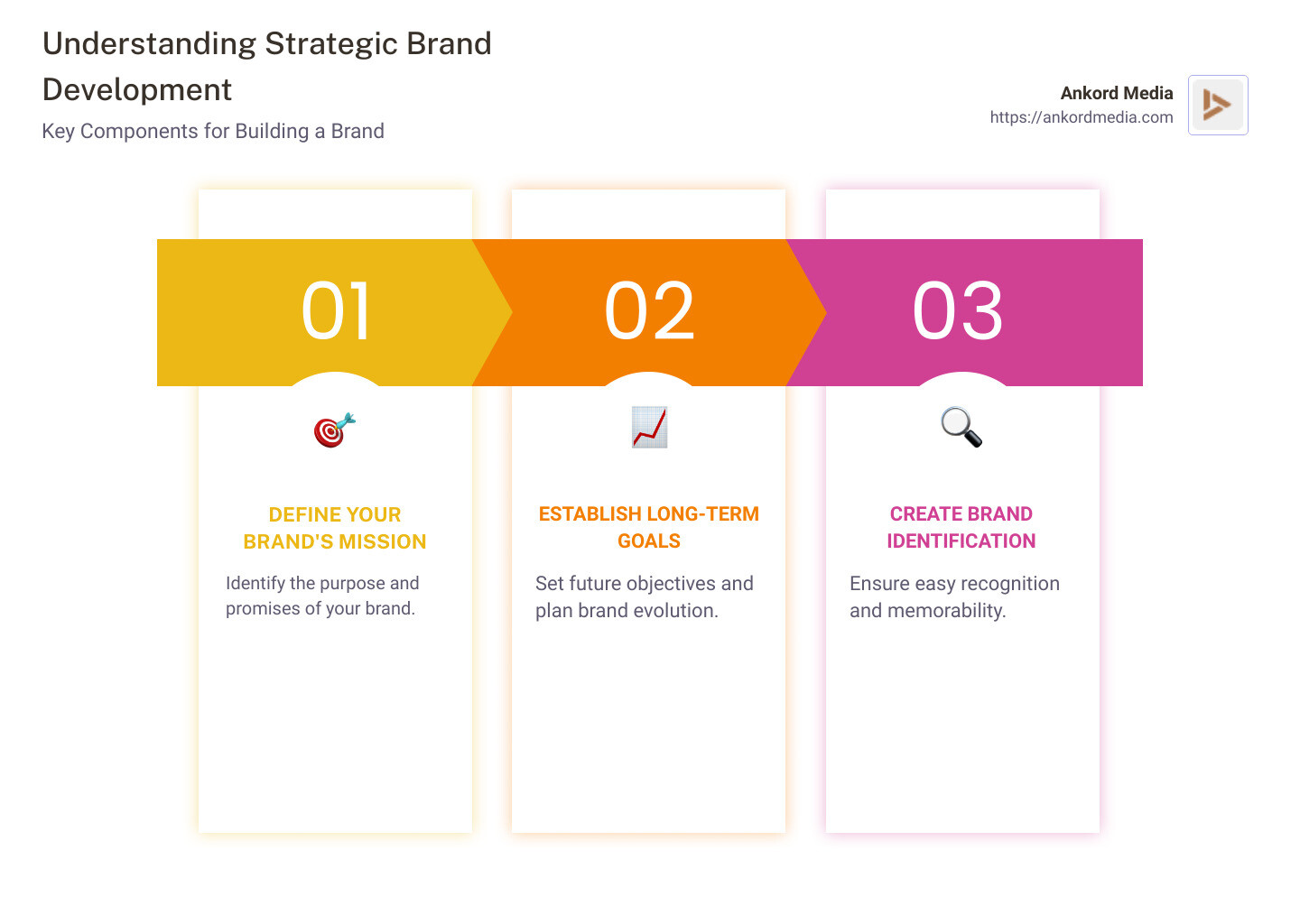
Strategic brand development is the blueprint for shaping your brand's future. It's a long-term plan that focuses on creating a unique identity and ensuring consumers can easily identify and prefer your brand over others. This involves aligning with your brand's mission, establishing clear long-term goals, and crafting an experience that resonates with your audience.
To start understanding strategic brand development, think of it as a combination of these essential elements:
- Define your brand's mission: What is the purpose of your brand, and what promises do you make to your customers?
- Establish your long-term goals: What are you striving to achieve in the future, and how will your brand evolve?
- Create brand identification: Ensure that your brand is easily recognizable and memorable to your target audience.
I'm Milan Kordestani, a Gen Z entrepreneur and the CEO of Ankord Media. My experience in strategic brand development involves crafting brand identities that not only captivate attention but also ensure deep connections with audiences. My approach focuses on blending innovation with strategic brand development to build compelling narratives and meaningful digital experiences.

Know your strategic brand development terms:- digital brand change- digital experience design- professional branding services
Understanding Strategic Brand Development
Strategic brand development is more than just a catchy logo or a memorable slogan. It's about crafting a comprehensive strategy that defines who you are, what you stand for, and how you connect with your audience.
Brand Development Process
The brand development process is a journey. It starts with research and moves through planning, execution, and evaluation.
- Research: Begin by understanding how your brand is currently perceived. This involves gathering insights from your target audience, competitors, and market trends. For instance, Heller Consulting realized their brand was too narrowly viewed as fundraising experts. By conducting thorough research, they could redefine their broader capabilities.
- Planning: Develop a clear plan that outlines your brand's mission, values, and unique selling proposition. What makes your brand different? How do you want people to feel when they interact with your brand?
- Execution: Implement your brand strategy across all channels. This includes your website, social media, and any customer touchpoints. Every piece of content should reflect your brand's essence and speak directly to your audience.
- Evaluation: Continuously monitor your brand's performance. Use data to track brand awareness, customer loyalty, and engagement. Adjust your strategy as needed to ensure it remains relevant and effective.
Brand Essence
The brand essence is the heart of your brand. It's the intangible attributes that define your brand's personality and values. Think of it as the emotional connection your audience feels towards your brand.
For example, Airbnb's brand essence revolves around belonging. They create a "home away from home" experience, making guests feel like they belong anywhere in the world. This emotional connection is what sets them apart from traditional hotels.
Target Audience
Identifying and understanding your target audience is crucial. Your brand should speak directly to the people who will benefit most from your products or services.
- Who are they?: Define the demographics, interests, and needs of your ideal customers.
- What do they value?: Understand what matters most to them and how your brand can meet those needs.
- How do they engage?: Identify the channels they use and the type of content that resonates with them.
By focusing on your target audience, you can create a brand experience that is both relevant and engaging. This alignment will help you build stronger, more meaningful connections with your customers.

Strategic brand development is about creating a cohesive and compelling brand that stands out in a crowded marketplace. By understanding the brand development process, defining your brand essence, and knowing your target audience, you can build a brand that not only attracts attention but also fosters loyalty and trust.
Next, let's explore the key pillars of brand strategy and how they contribute to building a successful brand.
Key Pillars of Brand Strategy
Building a strong brand isn't just about having a cool logo or catchy tagline. It's about establishing a strategic brand development plan that includes several key elements. Let's explore the essential pillars: positioning, value proposition, customer journey, and channels.
Positioning
Positioning is all about how your brand is perceived in the marketplace. It's the unique space you occupy in the minds of your target audience. To achieve effective positioning, you need to clearly differentiate yourself from competitors.
Think of positioning as your brand's "special sauce." What makes you different and better? For example, Airbnb's positioning focuses on offering a "home away from home," setting them apart from traditional hotels. This clear positioning helps them resonate with travelers seeking authentic experiences.
Value Proposition
Your value proposition is the promise of value your brand delivers. It's a clear statement that explains how your product or service solves a problem or improves a situation for your customers.
A strong value proposition should be simple, specific, and focused on the benefits that matter most to your target audience. For instance, Apple’s value proposition emphasizes innovation and user-friendly design, which appeals to tech-savvy consumers looking for cutting-edge technology.
Customer Journey
The customer journey is the path your customers take from first learning about your brand to making a purchase and beyond. Understanding this journey is crucial for creating a seamless and positive experience.
Mapping out the customer journey involves identifying key touchpoints where customers interact with your brand. This could be through your website, social media, or customer service channels. By optimizing these touchpoints, you ensure a consistent and engaging experience that fosters loyalty and encourages repeat business.
Channels
Channels are the platforms and methods you use to communicate with your audience. Choosing the right channels is vital for reaching your target customers effectively.
Consider where your audience spends their time and how they prefer to receive information. Are they active on social media? Do they prefer email newsletters or in-person events? Tailoring your strategy to the right channels ensures your message is heard and your brand remains top-of-mind.
Integrating multiple channels can significantly improve your reach and engagement. For example, using a mix of social media, email marketing, and content marketing can help you connect with a broader audience and reinforce your brand message.
By focusing on these key pillars—positioning, value proposition, customer journey, and channels—you can create a strategic brand development plan that not only attracts but also retains customers. Each pillar plays a crucial role in building a brand that stands out and thrives in a competitive market.
Now that we've explored the key pillars, let's look at some examples of successful brand strategies to see these principles in action.
Steps to Build a Successful Brand
Building a successful brand is like crafting a masterpiece. It requires a blend of creativity, strategy, and execution. Let's explore the essential steps to create a brand that not only stands out but also resonates with your target audience.
Business Strategy
Your brand should align with your overall business strategy. This means understanding your business goals and ensuring that your brand supports and improves them. A well-defined business strategy acts as the foundation upon which your brand is built.
Ask yourself: What are your long-term business objectives? How can your brand help achieve these goals? By aligning your brand with your business strategy, you create a cohesive vision that guides all your branding efforts.
Target Clients
Identifying your target clients is crucial for tailoring your brand to meet their needs. Conduct thorough research to understand who your ideal customers are, what they value, and how they behave. This knowledge will inform your brand positioning and messaging strategy.
Think of your target clients as the compass that directs your brand journey. By knowing who they are and what they want, you can create a brand that speaks directly to them and meets their expectations.
Brand Positioning
Brand positioning is about carving out a unique space in the market. It’s how you differentiate yourself from competitors and establish your brand identity. A clear positioning statement should define what makes your brand unique and why customers should choose you over others.
Take Airbnb as an example. Their brand positioning focuses on offering authentic travel experiences, setting them apart from traditional hotels. This distinct positioning resonates with travelers looking for unique and personal stays.
Messaging Strategy
A compelling messaging strategy translates your brand positioning into clear and engaging messages for your audience. Each audience segment may have different concerns and interests, so tailor your messaging to address these specific needs.
Consider creating an elevator pitch, sample headlines, and a messaging architecture document. This helps ensure that your messages are consistent across all channels and resonate with each target audience.
Content Marketing
Content marketing is a powerful tool for building brand awareness and reputation. By providing valuable, educational content, you can attract, nurture, and qualify prospects. This approach not only increases visibility but also strengthens your brand's reputation.
Focus on creating content that aligns with your brand's mission and speaks to your target audience's needs. Use various formats like blogs, videos, and social media posts to engage your audience and reinforce your brand message.
By following these steps—aligning with your business strategy, identifying target clients, defining brand positioning, crafting a messaging strategy, and leveraging content marketing—you can build a successful brand that not only attracts but also retains loyal customers. Each step is a vital component in the journey of strategic brand development.
Now, let's explore some examples of successful brand strategies to see these principles in action.
Examples of Successful Brand Strategies
Examining successful brand strategies provides valuable insights into the art and science of strategic brand development. Two standout examples are Airbnb and Apple. Both companies have mastered the art of brand identity and storytelling, setting benchmarks in their respective industries.
Airbnb: Creating a Sense of Belonging
Airbnb's brand strategy is a masterclass in storytelling and creating a unique brand identity. At its core, Airbnb offers more than just a place to stay. It provides a "home away from home" experience. This approach resonates with travelers seeking authentic and personalized experiences.
Storytelling plays a crucial role in Airbnb's strategy. They share captivating stories from hosts and guests across digital platforms like YouTube and Instagram. This storytelling builds an emotional connection with their audience, fostering trust and transparency.
Airbnb's brand identity is reinforced through consistent design elements. Their recognizable red and white color scheme evokes feelings of comfort and security, aligning with their mission to make people feel like they belong anywhere in the world.
Apple: The Power of Simplicity and Innovation
Apple's brand strategy is built on a foundation of simplicity, innovation, and emotional connection. Their ability to evoke emotions through their products and marketing is legendary. Apple's brand identity is synonymous with creativity, freedom, and empowering technology.
Apple's storytelling is evident in their marketing campaigns, which often focus on how their products improve users' lives. They use high-quality content, including visually stunning images and videos, to showcase the benefits of their products.
An essential aspect of Apple's strategy is their focus on a curated product selection and premium market positioning. This approach creates a 'halo effect,' making their products highly desirable and fostering a loyal customer base.
Key Takeaways
Both Airbnb and Apple demonstrate the power of strategic brand development through effective storytelling and a strong brand identity. They highlight the importance of creating emotional connections with customers and maintaining consistency in brand messaging and design.
These companies serve as inspiration for brands aiming to stand out in a crowded market. By crafting a unique brand identity and leveraging storytelling, businesses can build meaningful connections with their audience and achieve long-term success.
Frequently Asked Questions about Strategic Brand Development
What is strategic brand development?
Strategic brand development is all about creating a long-term plan to achieve specific goals. These goals help a brand become recognizable and preferred by its target audience. It's not just about a logo or color scheme. It's about building a strong identity that expresses the brand's mission and values. This approach helps create a connection with customers, fostering loyalty and trust over time.
What are the four pillars of brand strategy?
The four pillars of brand strategy are positioning, value proposition, customer journey, and channels.
- Positioning: This is how you want your brand to be perceived in the market compared to competitors. It's about finding a unique space that sets your brand apart.
- Value Proposition: This is the promise of value your brand offers to customers. It explains why customers should choose your brand over others.
- Customer Journey: This refers to the complete experience a customer has with your brand, from first awareness to purchase and beyond. Understanding this journey helps tailor interactions to improve customer satisfaction.
- Channels: These are the platforms you use to communicate with your audience. Whether it's social media, email, or in-person events, choosing the right channels is crucial for reaching your target audience effectively.
How do you identify your target audience?
Identifying your target audience involves thorough research and understanding of who will benefit most from your brand. Here’s how you can do it:
- Research: Start by gathering data on potential customers. Look at demographics, behaviors, and preferences. Tools like surveys and social media analytics can be helpful.
- Audience Engagement: Interact with your audience through various channels to understand their needs and desires. This can be done through social media polls, customer feedback, and direct communication.
- Define Target Clients: Based on your research, create detailed profiles of your ideal customers. Consider what problems they have and how your brand can solve them.
By focusing on these aspects, you can tailor your strategic brand development efforts to connect with the right people, ensuring your brand meets their needs and stands out in the marketplace.
Conclusion
At Ankord Media, we believe in the power of authentic connections and impactful storytelling to transform brands. Our approach is not just about crafting a visually appealing brand identity; it's about creating a narrative that resonates with your audience on a deeper level.
Authentic Connections: We focus on building genuine relationships with your customers. This means understanding their needs, values, and aspirations, and ensuring that your brand speaks to them in a meaningful way. By doing so, we help foster loyalty and trust, which are crucial for long-term success.
Impactful Storytelling: Storytelling is at the heart of strategic brand development. A compelling story captures your brand's essence and mission, making it memorable and relatable. At Ankord Media, we use storytelling to highlight your brand's unique value, creating a narrative that not only engages but also inspires your audience.
In today's digital landscape, your brand's story is told across various platforms. We ensure that your brand message is consistent and impactful, whether it's on your website, social media, or other channels. By leveraging cutting-edge design and technology, we craft digital experiences that lift your brand and accelerate growth.
To learn more about how Ankord Media can help you build a stronger brand future, visit our website and find how we can turn your visionary ideas into reality.
In summary, strategic brand development is an ongoing journey. It's about continuously evolving and adapting to meet the changing needs of your audience. With the right strategy, your brand can achieve lasting success and make a meaningful impact in the marketplace.


